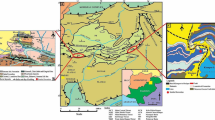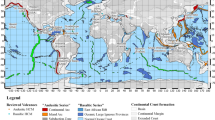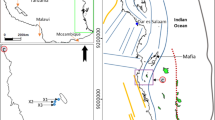Abstract
During its 13 years of non-continuous operation, the Osamu Utsumi Mine has generated serious environmental impacts. This mining complex is now attempting to decommission this uranium mine to reduce its environmental liabilities. As part of a hydrogeological analysis of the old Osamu Utsumi Mine pit area, a geophysical investigation was carried out along each front of the mine pit using electrical resistivity tomography and a dipole–dipole array. The lithology described in each front, the physical access, and data from monitoring wells also contributed to the geophysical interpretation and, hence, the hydrogeological analysis. The field results and geochemical data from monitoring wells enabled us to distinguish areas where water was flowing through fractures in the massif and areas with more acidic water, with electrical resistivity values less than 15 Ω m.
Zusammenfassung
In 13 Jahren ununterbrochenen Betriebs hat die Osamu Utsumi Mine schwerwiegende Umweltauswirkungen verursacht. Der Bergbaukomplex versucht nun, die Uranmine stillzulegen, um die Umweltbelastungen zu verringern. Im Rahmen einer hydrogeologischen Analyse des ehemaligen Grubengebiets der Osamu-Utsumi-Mine wurde eine geophysikalische Untersuchung entlang jeder Front der Grube mittels elektrischer Widerstandstomographie und einer Dipol-Dipol-Anordnung durchgeführt. Die jeweils beschriebene Lithologie, physischer Zugang und die Daten aus Überwachungsbrunnen trugen ebenfalls zur geophysikalischen Interpretation und damit zur hydrogeologischen Analyse bei. Anhand der Ergebnisse vor Ort und der geochemischen Daten aus den Überwachungsbohrungen konnten wir zwischen Bereichen, in denen Wasser durch Störungen im Massiv fließt, und Bereichen mit saurerem Wasser mit einem elektrischen Widerstand von weniger als 15 Ω∙m unterscheiden.
Resumen
Durante sus 13 años de funcionamiento discontinuo, la mina Osamu Utsumi ha generado graves impactos ambientales. Este complejo minero intenta ahora desmantelar esta mina de uranio para reducir sus responsabilidades medioambientales. Como parte de un análisis hidrogeológico de la zona del antiguo pozo de la mina Osamu Utsumi, se llevó a cabo una investigación geofísica a lo largo de cada frente del pozo de la mina utilizando tomografía de resistividad eléctrica y un arreglo dipolo-dipolo. La litología descrita en cada frente, el acceso físico y los datos de los pozos de control también contribuyeron a la interpretación geofísica y, por tanto, al análisis hidrogeológico. Los resultados de campo y los datos geoquímicos de los pozos de monitorización permitieron distinguir las zonas donde el agua fluía a través de las fracturas del macizo y las zonas con agua más ácida, con valores de resistividad eléctrica inferiores a 15 Ω∙m.
抽象的
在过去13年的不连续运营期间, Osamu Utsumi矿已产生了严重的环境影响。矿业联合体正试图关闭铀矿, 减少环境压力。作为Osamu Utsumi老矿坑区水文地质分析的一部分, 沿矿坑每个正面进行了电阻率层析成像和偶极-偶极电法物理勘探。每个正面的岩性描述、物理通道和监测孔数据也有助于地球物理解释和水文地质分析。现场结果和监测井地球化学数据帮助区分了穿过岩体裂隙的径流区和水酸性较强区, 电阻率值小于15Ω∙m。
Similar content being viewed by others
References
ABEM (2012) Terrameter LS—instruction manual. Sundbyberb, Sweden
ABNT NBR (Brazilian Association of Technical Standards) 15847 (2010) Amostragem de água subterrânea em poços de monitoramento—Métodos de purga. ABNT, Rio de Janeiro (In Portuguese)
Biondi JC (2015) Processos metalogenéticos e os depósitos minerais brasileiros. Oficina de texto, São Paulo (In Portuguese)
Buselli G, Lu K (2001) Groundwater contamination monitoring with multichannel electrical and electromagnetic methods. J Appl Geophys 48:11–23
Cipriani M (2002) Mitigação dos impactos sociais e ambientais decorrentes do fechamento definitivo de minas de urânio. PhD Diss, Univ of Campinas (In Portuguese)
Côrtes ARP, Moreira CA, Veloso DIK, Vieira LB, Bergonzoni FA (2016) Geoelectrical prospecting for a copper-sulfide mineralization in the Camaquã sedimentary basin, southern Brazil. Geofis Int 55(3):107–117
Degroot-Hedlin C, Constable S (1990) Occam`s inversion to generate smooth, two-dimensional models form magnetotelurric data. Geophysics 55(12):1613–1624
Ebraheem AM, Hamburger MW, Bayless ER, Krothe NC (1990) A study of acid mine drainage using earth resistivity measurements. Groundwater 28(3):361–368
Edwards LSA (1977) A modified pseudosection for resistivity and induced polarization. Geophysics 42(5):1020–1036
Epov MI, Yurkevich NV, Bortnikova SB, Karin YG, Saeva OP (2017) Analysis of mine waste by geocheimical and geophysical methods (a case study of the mine tailing dump of the Salair ore-processing plant). Russ Geol Geophys 58:1543–1552
Fernandes HM, Veiga LHS, Franklin MR, Prado VCS, Taddei JF (1995) Environmental impact assessment of uranium mining and milling facilities: a study case at the Poços de Caldas uranium mining and milling site. Brazil. J Geochem Explor 52:161–173
Fraenkel MO, Santos RC, Loureiro FEVP, Muniz WS (1985) Jazida de urânio no planalto de Poços de Caldas. Minas Gerais. DNPM. Principais depósitos minerais do Brasil. Recursos Minerais Energéticos 1(5):89–103
Franklin MR (2007) Modelagem numérica do escoamento hidrológico e dos processos geoquímicos aplicados à previsão da drenagem ácida em uma pilha de estéril da mina de urânio de Poços de Caldas, MG. PhD Diss, Univ Federal of Rio de Janeiro (In Portuguese)
Frid V, Averbach A, Frid M, Dudkinski D, Liskevich G (2017) Statistical analysis of resistivity anomalies caused by underground caves. Pure Appl Geophys 174:997–1012. https://doi.org/10.1007/s00024-015-1106-x
Garda MG (1990) A alteração hidrotermal no contexto da evolução geológica do maciço alcalino de Poços de Caldas, MG-SP. MSc thesis, Univ of São Paulo (In Portuguese)
Gélis C, Revil A, Cushing EM, Jougnot D, Lemeille F, Cabrera J, De Hoyos A, Rocher M (2010) Potential of electrical resistivity tomography to detect fault zones in limestone and argillaceous formations in the experimental platform of Tournemire. France Pure Appl Geophys 167:1405–1418
Gélis C, Noble M, Cabrera J, Penz S, Chauris H, Cushing EM (2015) Ability of high-resolution resistivity tomography to detect fault and fracture zones: application to the Tournemire experimental platform of France. Pure Appl Geophys 173:573–589
Ghosal S, Singh A, Agrahari S, Sengupta D (2020) Delineation of heavy mineral bearing placers by electrical resistivity and radiometric techniques along coastal Odisha. India. Pure Appl Geophys 177:4913–4923. https://doi.org/10.1007/s00024-020-02502-3
Gómez-Ortiz D, Martín-Velazquez S, Matín-Crespo T, De Ignácio-San José C, Lillo J (2010) Application of electrical resistivity tomography to the environmental characterization of abandoned massive sulphide mine ponds (Iberian Pyrite Belt. SW Spain). Near Surf Geophys 8:65–74
Hamdan H, Andronikidis N, Kritikakis G, Economou N, Agioutantis Z, Schilizzi P, Steiakakis C, Papageorgiou C, Tsourlos P, Vargemezis G, Vafidis A (2014) Contribution of electrical tomography methods in geotechnical investigations at Mavropigi lignite open pit mine, northern Greece. Environ Earth Sci 72(5):1589–1598
Holmes DC, Pitty AE, Noy DJ (1992) Geomorphological and hydrogeological features of the Poços de Caldas caldera analogue study sites. J Geochem Explor 45:215–247
Kearey P, Brooks M, Hill I (2002) An introduction to geophysical exploration. Wiley, Hoboken
Khalil MA, Bobst A, Mosolf J (2018) Utilizing 2D electrical resistivity tomography and very low frequency electromagnetics to investigate the hydrogeology of natural cold springs near Virginia City. southwest Montana. Pure Appl Geophys 175:3525–3538. https://doi.org/10.1007/s00024-018-1865-2
Korneeva T. Yurkevich N. Jucher D. Saeva O (2016) Geochemical and geophysical characterization of acid mine drainage and sulfide tailings at karabash mine site (South Ural. Russia). Int J Adv Res Sci Eng Technol 4(1):114–120
Legault JM, Carriere D, Petrie L (2008) Synthetic model testing and distributed acquisition dc resistivity results over an unconformity uranium target from the Athabasca Basin, northern Saskatchewan. Geophysics 27:46–51
Lghoul M, Teixidó T, Peña JA, Hakkou R, Kchikach A, Guérin R, Jaffal M, Zouhri L (2012) Electrical and seismic tomography used to image the structure of a tailings pond at the abandoned Kettara Mine. Morocco. Mine Water Environ 31:53–61. https://doi.org/10.1007/s10230-012-0172-x
Loke MH, Baker RD (1996) Rapid least-squares inversion of apparent resistivity pseudosections by quasi-Newton method. Geophys Prospect 44(1):131–152
Mackereth FJH (1978) Water analysis: some revised methods for limnologists. Titus Wilson & Son, Ltd, Kendal
Magno LB Jr (1985) Osamu Utsumi Mine. Geologic Presentation. In: Intern report of NUCLEBRÁS (In Portuguese)
Mandal A, Biswas A, Mittal S, Mohanty WK, Sharma SP, Sengupta P, Sen J, Bhatt AK (2013) Geophysical anomalies associated with uranium mineralization from Beldih Mine. South Purulia shear zone. India. J Geol Soc India 82:601–606
Martín-Crespo T, Gómez-Ortiz D, Martín-Velázquez S, Martínez-Pagán P, De Ignacio C, Lillo J, Faz A (2018) Geoenvironmental characterization of unstable abandoned mine tailings combining geophysical and geochemical methods (Cartagena-La Union district. Spain). Eng Geol 232:135–146. https://doi.org/10.1016/j.enggeo.2017.11.018
Martínez-Pagán P, Faz A, Aracil E, Arocena JM (2009) Electrical resistivity imaging revealed the spatial properties of mine tailing ponds in the Sierra Minera of southeast Spain. J Environ Eng Geophys 14:63–76
Martínez-Pagán P, Gómez-Ortiz D, Martín-Crespo T, Manteca JI, Rosique M (2013) The electrical resistivity tomography method in the detection of shallow mining cavities. A case study on the Victoria Cave. Cartagena (SE Spain). Eng Geol 156:1–10. https://doi.org/10.1016/j.enggeo.2013.01.013
Martínez-Pagán P, Gómez-Ortiz D, Martín-Crespo T, Matín-Velázquez S, Matínez-Segura M (2021) Electrical resistivity imaging applied to tailings ponds: an overview. Mine Water Environ 40:285–297. https://doi.org/10.1007/s10230-020-00741-3
McNeill JD (1980) Electromagnetic terrain conductivity measurement at low induction numbers. Technical note TN-6. Geonics Ltd, Mississauga
Merkel RH (1972) The use of resistivity techniques to delineate acid mine drainage in ground water. Ground Water 10(5):38–42
Moon CJ, Whateley MEG, Evans AM (2006) Introduction to mineral exploration. Wiley, Hoboken
Moreira EC, Fernandes LED, Pereira VP (2007) A Análise de Lineamentos Estruturaiz. Sob a Óptica da Geometria Fractal, no Maciço Alcalino de Poços de Caldas (MG). Revista Pesquisa em Geociências 34(2):89–97 (In Portuguese)
Moreira CA, Lapola MM, Carrara A (2016) Comparative analyzes among electrical resistivity tomography arrays in the characterization of flow structure in free aquifer. Geofis Int 55(2):119–129
Moreira CA, Helene LPI, Nogara P, Ilha LM (2018) Analysis of leaks from geomembrane in a sanitary landfill through models of electrical resistivity tomography in South Brazil. Environ Earth Sci. https://doi.org/10.1007/s12665-017-7180-x
Moreira CA, Casagrande MFS, Siqueira Büchi FM, Targa DA (2020) Hydrogelogical characterization of a waste rock pile and bedrock affected by acid mine drainage from geophysical survey. SN Appl Sci 2:1236. https://doi.org/10.1007/s42452-020-3021-8
Mwenifumbo CJ, Elliot BE, Jefferson CW, Bernius GR, Pflug KA (2004) Physical rock properties from the Athabasca Group: designing geophysical exploration models for unconformity uranium deposits. J Appl Geophys 55:117–135
Obiadi II, Onwuemesi AG, Anike OL, Ajaegwu NE, Anakwuba EK, Nwosu CM, Akpunonu EO, Onuigbo EN, Onuba OL (2013) Determining subsurface fracture characteristics from the azimuthal square array resistivity survey at igarra. Niger Pure Appl Geophys 170:907–916. https://doi.org/10.1007/s00024-011-0443-7
Oliveti I, Cardarelli E (2019) Self-potential data inversion for environmental and hydrogeological investigations. Pure Appl Geophys 176:3607–3628. https://doi.org/10.1007/s00024-019-02155-x
Pires FRM (2013) Urânio no Brasil: geologia, jazidas e ocorrências. Eletrobrás Eletronuclear. Rio de Janeiro (In Portuguese)
Placencia-Gómez E, Parviainen A, Hokkanen T, Loukola-Ruskeeniemi K (2010) Integrated geophysical and geochemical study on AMD generation at the Haveri Au–Cu mine tailings. SW Finl Environ Earth Sci 61:1435–1447
Poisson J, Chouteau M, Aubertin M, Campos D (2009) Geophysical experiments to image the shallow internal structure and the moisture distribution of a mine waste rock pile. J Appl Geophys 67:179–192
Rucker DF, Glaser DR, Osborne T, Maehl WC (2009) Electrical resistivity characterization of a reclaimed gold mine to delineate acid rock drainage pathways. Mine Water Environ 28:146–157
Targa DA, Moreira CA, Camarero PL, Casagrande MFS, Alberti HLC (2019) Structural analysis and geophysical survey for hydrogeological diagnosis in uranium mine. Poços de Caldas (Brazil). SN Appl Sci 1:299. https://doi.org/10.1007/s42452-019-0309-7
Targa DA, Moreira CA, Casagrande MFS (2021) Hydrogeological analysis of sulfide tailings at a uranium mine using geophysical and hydrochemical methods. Mine Water Environ. https://doi.org/10.1007/s10230-021-00791-1
Tuncer V, Unsworth MJ, Siripunvaraporn W, Craven JA (2006) Exploration for unconformity-type uranium deposits with audiomagnetotelluric data: a case study from the McArthur River mine. Sask Can Geophys 71(6):201–209
Waber N, Schorscher HD, Peters T (1992) Hydrothermal and supergene uranium mineralization at the Osamu Utsumi mine, Poços de Caldas, Minas Gerais, Brazil. J Geochem Explor 45:53–112
Yuval D, Oldenburg W (1996) DC Resistivity and IP methods in acid mine drainage problems: results from the Copper Cliff mine tailings impoundments. Appl Geophys 34:187–198
Zhang G, Lü QT, Zhang GB, Lin PR, Jia ZY, Kui S (2018) Joint interpretation of geological, magnetic, AMT, and ERT data for mineral exploration in the northeast of inner Mongolia. China Pure Appl Geophys 175:989–1002. https://doi.org/10.1007/s00024-017-1733-5
Acknowledgements
This study was financed in part by the Coordenação de Aperfeiçoamento de Pessoal de Nível Superior - Brasil (CAPES) - Finance Code 001. The authors thank Coordenação de Aperfeiçoamento de Pessoal de Nível Superior (CAPES), the Foundation for Research Support of the State of Sao Paulo (Fundação de Amparo a Pesquisa do Estado de São Paulo - FAPESP) and the INB for their support.
Author information
Authors and Affiliations
Corresponding author
Additional information
Publisher’s Note
Springer Nature remains neutral with regard to jurisdictional claims in published maps and institutional affiliations.
Rights and permissions
About this article
Cite this article
Camarero, P.L., Moreira, C.A., Targa, D.A. et al. Analysis of Acid Drainage Flow Zones in a Rocky Massif in a Uranium Mine from Structural and Geophysical Diagnoses. Mine Water Environ 41, 303–316 (2022). https://doi.org/10.1007/s10230-021-00827-6
Received:
Accepted:
Published:
Issue Date:
DOI: https://doi.org/10.1007/s10230-021-00827-6














